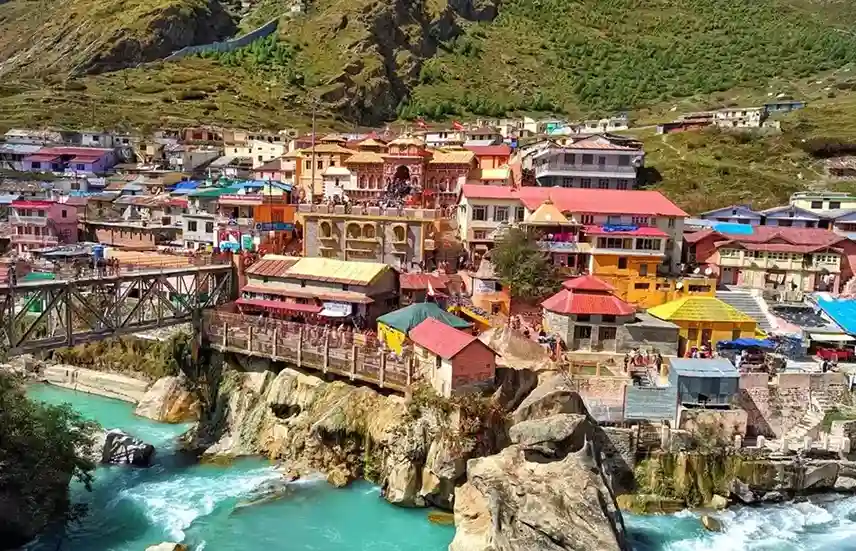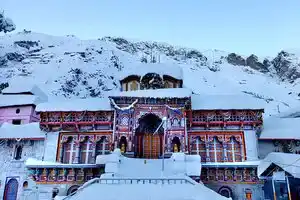Badrinath Temple - The Celestial Abode of Lord Vishnu
Home » Badrinath Dham »
Situated at an altitude of 3,300 meters above sea level, the vibrantly colored Dham of Badrinath is not only one of the most revered Charm Dhams of Uttarakhand but it also forms a part of both the Chota Char Dham Yatra in Uttarakhand and the All India Char Dham circuit, which includes Dwarkadhish, Jagannath, and Rameshwaram temples. With the Nar and Narayan peaks in the backdrop and the Alaknanda River flowing beside it, Badrinath temple’s natural beauty and spiritual aura attract hundreds of thousands of devotees every year.

Legends of Badrinath
There are numerous legends and myths regarding the establishment of the temple some of which are:
Lakshmi’s Devotion
It is said that once Lord Vishnu meditated here, the weather changed dramatically, and the lord was unaware of it. In order to protect his consort, Goddess Lakshmi, took the form of a Badri tree and shielded him. Seeing this, Lord Vishnu was pleased by her deep devotion and named this region Badrikashram in her honor.
Vishnu in Disguise
Another myth declares that once when Lord Shiva and Goddess Parvati were doing their Tapasya in Badrinath, Lord Vishnu decided to meet them as a crying child. When goddess Parvati asked him the reason behind his sadness, he said that he desired to meditate in Badrinath. Later, both Shiv and Parvati found that it was Lord Narayan in disguise, blessing the land with his presence.
The Hermitage of Nar and Narayan
It is also believed that once two brothers, who were sons of Dharma, Nar and Narayan wanted to set up their Hermitage in order to expand their spiritual base among the peaceful Himalayas. While they were searching for this ideal location they chanced upon the Panch Badri which finally led them to Badrinath which was sitting behind the holy river Ganga. They were extremely elated about the place and named it Badri Vishal.
Origin of the Sacred River Alaknanda
The holy River Ganga had granted Bhagirath’s request to relieve the people of the earthly realm from all their sins. As per legend, when Ganga agreed to descend from heaven to Earth, her flow was too powerful. This is why Lord Shiva had to come and catch her in his matted locks and split her into multiple streams. Finally, the massive river was divided into different streams, one of them being Alaknanda.
Architecture of Badrinath Temple
Sitting majestically amidst the lush greenery of the Garhwal Himalayan region of Chamoli district, this iconic temple is located at an elevation of 3,133 meters above sea level. With a glorious backdrop of the mighty Nar and Narayan Parbat, the temple structure is of a traditional Indian fashion. The entire structure is built out of strong mountain stones and consists of arched windows.
Exterior Highlights:
- Constructed with stone masonry.
- A brightly painted facade with arched windows.
- The main gateway leads to a large stairway reaching the Mandap (hall).
- The Garbhagriha (sanctum) features a gilded gold roof and a small cupola.
Interior Layout:
- A spacious Mandap with intricately carved pillars.
- The inner sanctum houses the temple's main deity and is adorned with delicate engravings.
Inside the Temple: The Deities
The spiritual core of the temple lies within its Garbhagriha, where numerous revered idols are preserved.
Main Idol: Badrinarayan
- A 1-metre-tall black stone (Shaligram) idol of Lord Badrinarayan.
- Enshrined under a golden canopy shaped like a Badri tree.
- The idol holds a conch (Shankha) and discus (chakra) in two hands, while the other two are in a yoga mudra.
Other Deities Present inside the Temple:
- Goddess Lakshmi
- Garuda (Vishnu’s mount)
- Kuber (God of wealth)
- Sage Narada
- Uddhav
- Nar and Narayan
- Navadurga – the nine forms of Goddess Durga
The temple also consists of shrines dedicated to Adi Shankaracharya, Lakshmi Narasimha, Vedanta Desika, Ramanujacharya, and others. All these idols are created out of black stones.
Conclusion
Badrinath temple is the most sacred place that offers spiritual experiences like no other. Enveloped in myths, natural beauty, and centuries of faith, this shrine attracts devotees from different parts of the world. If you are in search of peace, devotion, and a divine connection with Lord Vishnu, ensure you visit Badrinath Dham at least once in your lifetime.

Leave a Reply